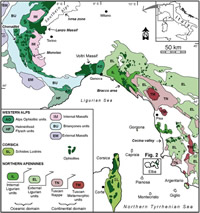The Cotoncello Shear Zone (Elba Island, Italy): The deep root of a fossil oceanic detachment fault in the Ligurian ophiolites
Frassi C., G. Musumeci, M. Zucali, F. Mazzarini, G. Rebay, A. Langone (2017).
Lithos, 278/281, 445-463, doi: https://doi.org/10.1016/j.lithos.2017.02.015.
Abstract
The ophiolite sequences in the western Elba Island are classically interpreted as a well-exposed ocean-floor section emplaced during the Apennines orogeny at the top of the tectonic nappe-stack. Stratigraphic, petrological and geochemical features indicate that these ophiolite sequences are remnants of slow-ultraslow spreading oceanic lithosphere analogous to the present-day Mid-Atlantic Ridge and Southwest Indian Ridge.
Within the oceanward section of Tethyan lithosphere exposed in the Elba Island, we investigated for the first time a 10s of meters-thick structure, the Cotoncello Shear Zone (CSZ), that records high-temperature ductile deformation. We used a multidisciplinary approach to document the tectono-metamorphic evolution of the shear zone and its role during spreading of the western Tethys. In addition, we used zircon U–Pb ages to date formation of the gabbroic lower crust in this sector of the Apennines. Our results indicate that the CSZ rooted below the brittle–ductile transition at temperature above 800 °C. A high-temperature ductile fabric was overprinted by fabrics recorded during progressive exhumation up to shallower levers under temperature < 500 °C. We suggest that the CSZ may represent the deep root of a detachment fault that accomplished exhumation of an ancient oceanic core complex (OCC) in between two stages of magmatic accretion. We suggest that the CSZ represents an excellent on-land example enabling to assess relationships between magmatism and deformation when extensional oceanic detachments are at work.
https://www.sciencedirect.com/science/article/pii/S0024493717300713


